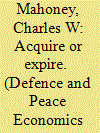|
|
|
Sort Order |
|
|
|
Items / Page
|
|
|
|
|
|
|
| Srl | Item |
| 1 |
ID:
178021


|
|
|
|
|
| Summary/Abstract |
The U.S. government increasingly outsources important national security responsibilities to defense contractors. In addition to manufacturing hardware and weapons, corporations now supply much of the specialized labor used by American defense and intelligence agencies to execute cyber operations, train foreign militaries, analyze top-secret information, and pilot unmanned aerial vehicles. This study examines the current state of affairs in the U.S. defense industry and demonstrates that publicly traded corporations are awarded the lion’s share of U.S. contracting dollars spent on national defense. Subsequently, the inquiry argues that publicly traded corporations possess a competitive advantage over privately held companies in the U.S. defense industry because of their superior ability to raise capital through initial public offerings, follow-on share sales, and access to debt supplied by financial institutions. In recent years, publicly traded defense contractors have used these financial strategies to make major acquisitions, increase their competitiveness, and consolidate market share in the American defense industry.
|
|
|
|
|
|
|
|
|
|
|
|
|
|
|
|
| 2 |
ID:
153936


|
|
|
|
|
| Summary/Abstract |
Private military and security companies are integral components of the defense and intelligence operations of some of the world's most powerful states. Despite the increasingly pivotal role of contractors, analysts have yet to develop theories explaining when governments should outsource national security responsibilities or what conditions cause private defense markets to function efficiently. This inquiry addresses this gap in the literature by demonstrating that varying market structures—that is, the quantity of firms providing similar services and the number and purchasing power of those buying these services—have significant effects on costs, oversight, and company performance in the private defense industry. A principal–agent framework is developed to explain variation in the performance of firms in different markets across the industry. Evaluation of three private defense markets yields the surprising conclusion that monopsony, rather than a competitive market, is the ideal structure for governments outsourcing aspects of national defense.
|
|
|
|
|
|
|
|
|
|
|
|
|
|
|
|
| 3 |
ID:
175587


|
|
|
|
|
| Summary/Abstract |
Why do extremist organizations issue terrorist bluffs? According to previous research, empty threats against civilians are likely to negatively influence assessments of groups’ strength and credibility, thus making it more difficult for extremists to achieve their goals. Despite these potential audience costs, bluffing is a common terrorist tactic. This inquiry assesses data on the bluffing patterns of three organizations—Boko Haram, Jamaat-ul-Ahrar, and the Real Irish Republican Army—and finds that groups suffer few costs for making empty terrorist threats. Furthermore, extremists bluff to advance a variety of strategic goals including outbidding rival factions, spoiling peace settlements, and intimidating civilians.
|
|
|
|
|
|
|
|
|
|
|
|
|
|
|
|
| 4 |
ID:
164149


|
|
|
|
|
| Summary/Abstract |
In May 2018, the Basque insurgent group Euskadi Ta Askatasuna (ETA) officially disbanded after a 60-year struggle. This inquiry assesses ETA’s violent campaigns using recent conceptual and theoretical advancements from the field of terrorism studies. Three conclusions concerning the group’s strategies of terrorism are advanced. First, ETA regularly targeted civilians to achieve goals other than coercing the Government of Spain; these objectives included outbidding rival separatist groups and spoiling negotiation processes. Second, ETA’s most rapid period of organizational growth occurred as the result of an aggressive terrorist campaign, demonstrating that civilian targeting can serve as a stimulus to rebel group recruitment. Finally, while terrorism did not advance ETA’s primary political objective of creating an independent Basque state, it did enable the group to assume a leading position within the radical Basque separatist movement, helping extend ETA’s lifespan and making the group an embedded actor within the contentious political processes surrounding the question of Basque self-determination. Collectively, these conclusions support recent theoretical findings arguing that non-state terrorism often enables insurgent groups to prolong their lifespans while paradoxically making it more difficult for them to advance their long-term political objectives.
|
|
|
|
|
|
|
|
|
|
|
|
|
|
|
|
| 5 |
ID:
163752


|
|
|
|
|
| Summary/Abstract |
The quality of social science inquiry examining terrorism, insurgency, and nonviolent civil resistance has progressed rapidly in recent years. One reason for this advancement is the emergence of new datasets and the subsequent application of quantitative methods to the analysis of asymmetric political conflict between states and nonstate actors. Despite rapid development within the research paradigm, the use of new data has coincided with several methodological and conceptual challenges. This inquiry employs insights from qualitative social science methodology and organizational sociology to highlight and propose solutions to three shortcomings found in recent quantitative analyses of asymmetric conflict. The first problem arises from scholars’ proclivity to ask research questions based on easily accessible categories of data rather than on theoretically significant puzzles in the literature. The second pitfall concerns limitations and “conceptual stretching” associated with static, nominal variables constructed to enable statistical inference. Finally, the third class of research obstacles arises from selection bias caused by underreporting of data. Each of these methodological problems potentially undermines theoretical claims made in recent work on insurgent organizations, terrorism, civil war, and nonviolent resistance.
|
|
|
|
|
|
|
|
|
|
|
|
|
|
|
|
| 6 |
ID:
172182


|
|
|
|
|
| Summary/Abstract |
Insurgent organizations often experience internal fragmentation when a faction breaks away to form a separate group with independent leadership. Following a split, what factors influence the relative durability and status of groups within larger nationalist movements? Existing theory attributes variation in groups’ performance after a division to rebel strategy. Specifically, some work argues that extremist groups using violence will outbid more moderate competitors; however, alternate research contends organizations using strategic non-violence will have more success. Contrary to previous work, this inquiry argues that in many instances rebel strategy following a split has little influence on the duration and status of groups. Instead, organizations’ relative membership size at the time of a division is the most important factor influencing their subsequent performance. That is, after a split larger core groups are more likely to survive for longer periods and to advance within their broader nationalist movements than splinter groups. However, in cases when divisions result in groups of similar size and strength, strategy may still play a significant role in rebel organizations’ comparative longevity and status.
|
|
|
|
|
|
|
|
|
|
|
|
|
|
|
|
| 7 |
ID:
171647


|
|
|
|
|
| Summary/Abstract |
The United States’ global strategic outlook has shifted markedly since the end of major combat operations in Iraq and Afghanistan. As the United States’ strategic posture shifts, the nature of military operations is simultaneously changing rapidly. Many analysts predict that cyber-operations, autonomous weapons systems, artificial intelligence, and clandestine special forces operations will be central features in future conflicts. Although often overlooked by scholars and policy analysts, defence contractors are integral to the development and implementation of these emerging categories of warfare. This inquiry examines the evolving nature of the American defence industry and the roles corporations play in current theatres of conflict. Surprisingly, rather than becoming less reliant on defence contractors after their much-maligned performance in the wars in Iraq and Afghanistan, American military and intelligence agencies have become more dependent on the private sector as technology becomes increasingly central to warfare.
|
|
|
|
|
|
|
|
|
|
|
|
|
|
|
|
|
|
|
|
|